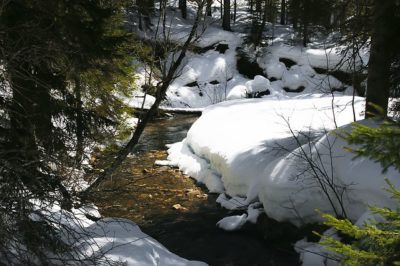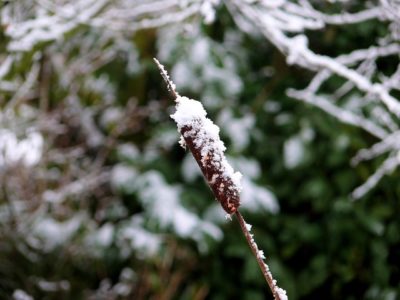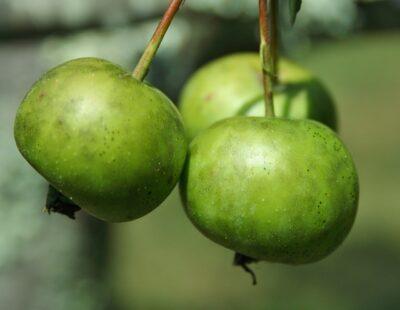The following blog post 8 Survival Foods You Can Forage For In The Dead Of Winter Read more on: http://totalsurvival.net
8 Survival Foods For Winter Foraging
I’ve instructed a number of field classes on foraging for wild foods and have written about it quite a bit, too. The classes always took place in the spring, summer or fall and the articles focused on plants, berries and other wild edibles that were easy to find on a sunny, summer day. But what about winter? Well, I’ve done that, too — and it’s tough.
For the record, we’re talking about serious winter. Not a cold night in the desert or a brisk wind in the southeast. This is below-zero stuff.
It is possible to find food in the winter, but let’s first look at four factors that will complicate your winter foraging:
1. It’s cold
This not only affects what you’re trying to find and gather, but it’ll eventually affect you. Cold also can freeze the ground, which will limit your access to some roots and tubers.
2. There’s snow
Snow covers and obscures many of the things you’ll be looking for. You need to look for clues above the snow. An oak tree is a good indication that acorns may be on the ground under the snow. Some oak trees hold their leaves on their branches over the winter. That helps. We’ll cover some other clues for those snowy days.
3. It’s wet
A lot of us like to harvest cattails in the winter. But sloshing through a foot or two of water and reaching deep into water and mud is going to take its toll on you quickly, if you’re not prepared.
4. Less than 10 percent is still available
If you’re in a winter climate, most stuff is dead or not growing. Your options are limited for any harvest at around 10 percent, depending on where you live.
In winter, we lose some of the indicators that help us find food — especially the prolific appearance of leaves. However, some indicators are still out there.

8 Survival Foods For Winter Foraging
I found a grove of wild plums two days ago in late January. I recognized the shape and concentration of the trees, but the real giveaway was the frozen little plums still on their branches. They made a great jelly. Fruits visible on a tree or plant also could include rose-hips, cranberries and crabapples.
Take note of the shape and appearance of bark on trees, especially nut-bearing trees like oak, horse chestnut and black walnut. Take the time to learn and recognize the bark and the physical characteristics of nut-bearing trees. One clue is a squirrel’s nest in a tree — although the squirrel may have gotten too many of the acorns before you arrive.
Some plants continue to photosynthesize under the snow. Scraping the snow might reveal some of this winter treasure, including dandelion, wild onion and chickweed.
Go in the water, but carefully. Water sources have an abundance of food in the winter. If you live by the ocean, tide-pools at low-tide can provide shellfish and plants like kelp or seaweed. Freshwater springs, creeks and ponds often will have stands of cattails, fresh water mussels under the mud and muck, and the occasional crayfish. But you have to be dressed for any water foraging, so let’s get into how to dress and equip for winter foraging.
Here’s what you should look for:

Cattails: Survival Foods For Winter Foraging
1. Cattails
The roots, when washed and peeled, are an excellent starch source with a potato-like flavor and can be prepared like potatoes. They also can be dried and made into a flour.
2. Acorns, black walnuts and horse chestnuts
These are found on the ground under nut-bearing trees. You should soak them for three days with three changes of water to remove tannins and then either roast them, or boil and dry and grind into flour.
3. Rose hips
Usually bright red and about one-quarter-inch to a half-inch in diameter. Make into a jelly or infuse in a tea. One of the highest sources of vitamin C in the wild.
4. Fresh water mussels
I often encounter these while foraging for cattail roots. They usually grow in beds. Where you find one, you’ll find others. Scrape them up from the mud with your small, hand rake. Wash and scrub carefully and boil until shells open and then boil some more. If they are from a suspected polluted water source, then don’t eat them. In fact, don’t eat anything from a water source that is suspect.
5. Mushrooms
Curiously resilient even in winter and will sometimes appear after a brief thaw. Look for them on rotting deadfalls. Check out some pictures so you know what you’re eating. Even in winter, some mushrooms are toxic.
6. Wild greens
Dandelion roots and crowns, wild onions, chickweed, wild garlic. They’ll betray themselves with a showing of green under the snow or poking through the leaf litter. Rinse and boil with salt and eat like greens.
7. Watercress
Evident as a large bloom of green flowing in springs and creeks. Easy to harvest in bulk and can be eaten raw as a salad.

Crabapples: Survival Foods For Winter Foraging
8. Wild fruits like plums and crabapples
Usually apparent still hanging from their trees. Mash into a jelly or strain as a juice blended with water, sugar and boiled.
It goes without saying that you should dress warmly and dress in layers when foraging. There are going to be varying degrees of exertion and rest, and you want to be able to manage your perspiration.
Here are a few more tips that have benefited me when winter foraging:
If I’m going to harvest cattails, that’s usually all I’ll do. I’ll wear water-proof boots and have even donned insulated hip-waders. I also wear heavy-duty rubber gloves that go up to my bicep with a layer of insulated gloves underneath. Rooting around in the mud with your bare hands is going to be a short-term effort in the winter. You also need to harvest a good amount of things like cattails if you’re seriously thinking about making a meal.
The same equipment and preparation applies for looking for mussels, although I’ll bring along my little three-pronged hand rake like I do for wild nuts. I’ll also bring along a five-gallon plastic bucket if I’m foraging in water. It does a better job of containing the residual water, mud and muck.
Wild Nuts
If I’m going to pursue wild nuts like acorns or black walnuts, I’ll leave the rubber boots and rubber gloves at home, but I’ll make sure I have the small, three-pronged hand rake. Scratching your gloved hand through the snow and leaf-litter will get your gloves wet and not be as efficient as scraping the surface with a small rake and picking out the nuts.
Frozen Berries
If my goal is to find frozen fruits or berries like rose-hips, wild plums, crab-apples or other frozen fruits, I’ll make sure I have a supply of plastic bags in one-gallon, one-quart and sandwich sizes to contain the fruits. It’ll be a lot easier when you get home to sort and wash the berries or fruits rather than tossing all of them in a side-pack or sack.
Winter-greens
If I’m looking for wild, winter-greens, I’ll have some kitchen shears and my little hand rake. I’ll also have plenty of one-gallon plastic bags. The rake helps to separate the matted greens from the leaf litter and some of the stems can be tough, so the kitchen shears help.
Collecting your foraged foods requires the ability to potentially carry a few pounds or more in a way that keeps them separate and any water or snow contained. I usually have two, canvas side-satchels or even a small backpack. Sometimes I’ll insert a plastic, kitchen-sized garbage bag into the satchels or the backpack, or use the smaller plastic bags to keep things organized and dry. Sometimes, the five-gallon plastic bucket comes along for the hike.
Don’t forget to bring along a bottle of water or two and if you’re going far afield and a small, waterproof survival kit. If you trip and fall into water when it’s 10 below and you’re four miles from anywhere, you’ll need to be able to build a fire fast.
Winter foraging is slim-pickings. I’ve seen too many articles that seem to make this all so easy. It’s tough, it’s cold, and it’s hard work, especially if you’re trying to find any wild plants in winter. But if you know what you’re doing, you can find food … and survive.
Related:
Black Walnuts: How To Crack (And Cook With) Nature’s Toughest Nut
Have you tried winter foraging? What advice would you add? Share it in the section below:
The post 8 Survival Foods You Can Forage For In The Dead Of Winter appeared first on Off The Grid News.
This Article Was Originally Posted On offthegridnews.com Read the Original Article hereArticle Source Here: 8 Survival Foods You Can Forage For In The Dead Of Winter
No comments:
Post a Comment